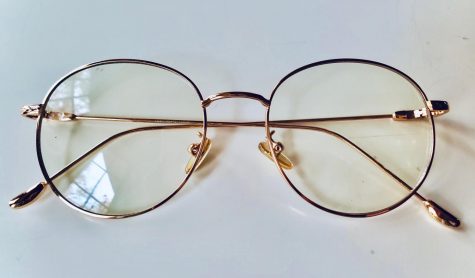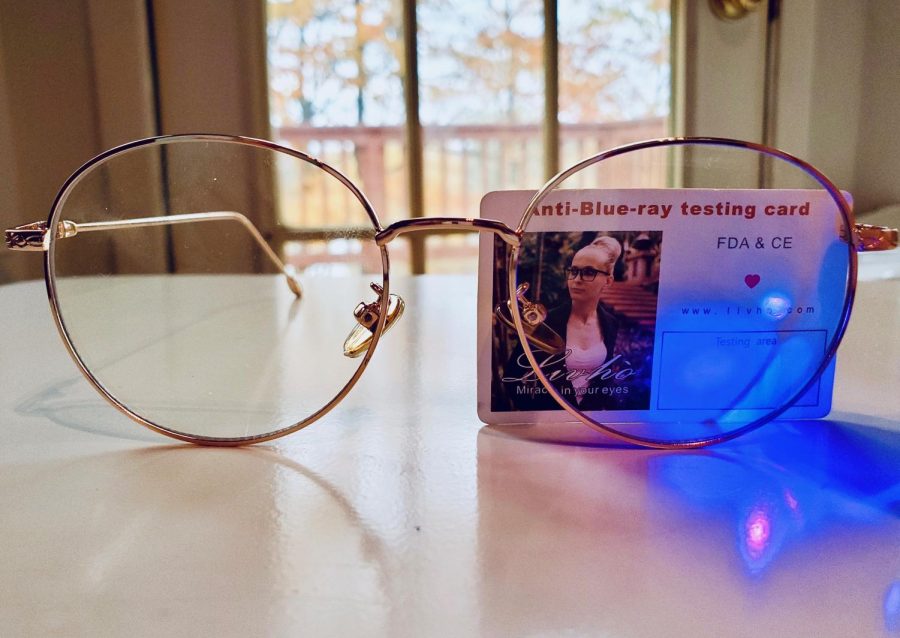The visor for your eyes: Blue light glasses
In the era of screen-staring for eight hours prolonged by after school Zoom calls and the onslaught of online assignments, blue light glasses have been a rising savior to protect the withering eyes and headaches of countless online souls.
And for the curious souls, I decided to purchase a pair in hopes of seeing if companies were just labeling plastic glasses as “UV light resistant” and happily profiting off the growing surge of expectant consumers.
I was constantly experiencing dry eyes during online school. It got to the point where I tried wearing sunglasses which only succeeded in making me look like a fool.
But you don’t need angrily twitching eyes or Sahara-dry eyes to purchase a pair of your own. In fact, you may want to make an investment to maintain healthy eyes in the long run and to prevent those types of symptoms from occurring in the near future.
The magic of these glasses wasn’t instantaneous, but the differences between wearing them and not wearing them were definitely noticeable after a few days. The daily migraines I’d get started to dissipate, and I would go to bed without feeling as if my eyes were stripped of their moisture. My eyes just felt fresher.
Call it Placebo, but the testing and design of these lenses say otherwise.
Blue-light glasses usually come with a small “kit” consisting of a blue light projector––which I’ve yet to find a better noun for––and a small, reusable card that lets the customer test the effectiveness of the glasses.
If you shine the projector directly on to the card, the targeted section should become a dark shade of purple, an indication of blue light exposure. To test the glasses, place the card behind the lens and repeat the same procedure.

For comparison, I examined the resistance of my new glasses and used the same projector on a pair of nearly identical, non-blue light glasses that I already owned.
I had to amp up the intensity of light exposure by directly placing the projector onto the lens for a solid 10 seconds to see the true comparisons. Here’s what I found:

The card behind the non-blue light glasses held a small, purple spot.
The card behind the actual blue light glasses also held a purple spot, but it was much fainter and less concentrated than the counter product.
Which means there is a blue blocking component within the blue light glasses.
It’s important to note that this “projector” emits a much stronger concentration of light than the average piece of technology would typically emit. So, for less than $15, the level of protection these glasses carry seems like a pretty good deal.
You may notice the slightest tint of yellow in your blue light glasses, which I only noticed on mine when comparing it to the non-blue light glasses.
According to BluBox, an Australian speaker and blue-light glasses company, this yellow tint is what blocks around 50% of blue light. So, if a brand claims to do more than that, then it’s probably an exaggerated advertisement. For example, my glasses marketed as having the ability to block 99.999% of blue light, when in fact, it’s likely half of that. Nonetheless, that over-exaggeration doesn’t always mean that the actual product has zero protection.
The yellow tinted lens are also infused with a color therapy that primarily benefits people who have acute light sensitivity, migraines, Seasonal Affective Disorder (SAD), anxiety, depression, and high levels of stress. Despite its role in enhancing alertness and cognitive performance during the day, blue light can also increase the production of a hormone called cortisol, which intensifies these symptoms.

Likewise, other colors, or no tint at all, serve different purposes. The most common working glasses with no tint mainly combat fatigue and eyestrain with a blocking percentage between 5-30%.
If you’re interested in blue-blocking capability that reaches nearly 100%, orange and red tinted glasses may be the best fit, although they’re mainly designed to optimize sleep, since according to an Oxford study consistent exposure to light can disrupt one’s circadian rhythm––the body’s natural clock.
For a truly authentic, durable product, you may opt to buy a more expensive pair from a company that specializes in making glasses, such as Felix Gray and Quay.
But honestly, a pair off of Amazon should still warrant a sufficient amount of protection from your screens for a much lower price.
Either way, it’s probably better to obtain these blue light glasses than to not. It offers long term protection of your eyes that can result in a sense of refreshment, enhanced sleep, and concentration.


